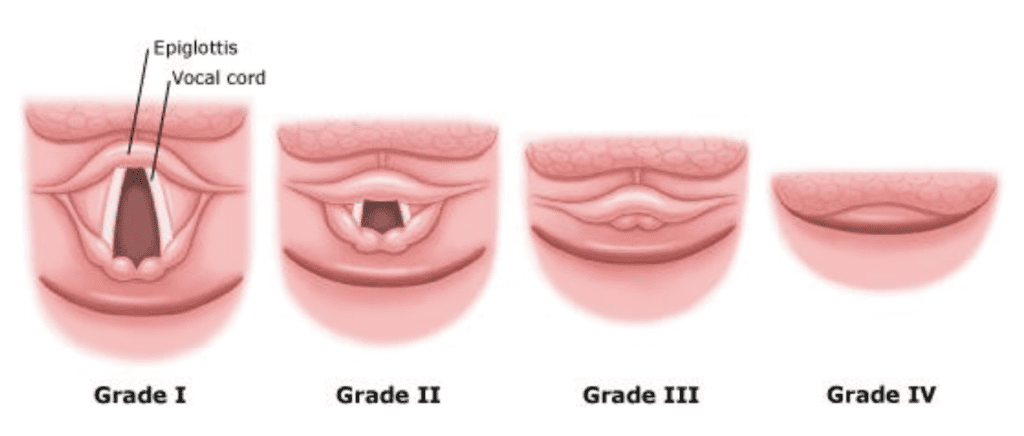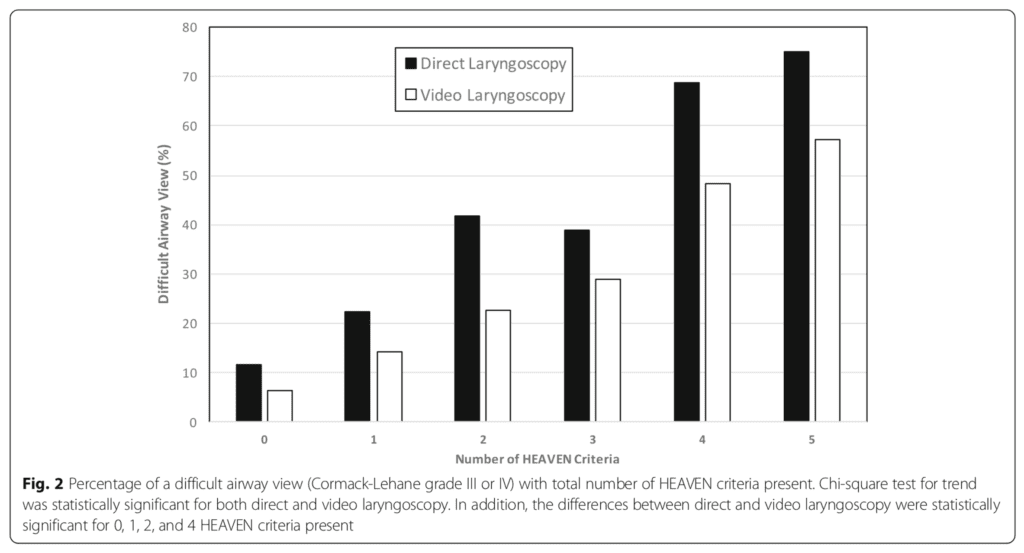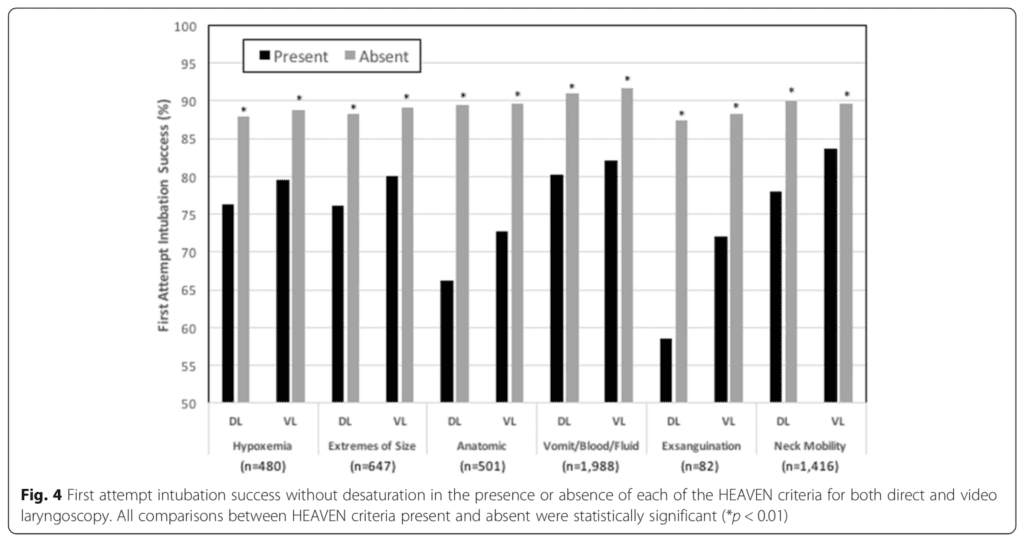
 Background: Predicting a challenging airway is important to assist in the most optimal approach to airway management during RSI. Two such tools include the Mallampati and LEMON scores and were derived in the pre-operative setting. Major limitations of these scores include the requirement of patients to be awake and cooperative and they don’t incorporate physiologic factors into them. The HEAVEN criteria is a recently developed tool thought to be more relevant and feasible for emergency airway assessment. Each letter of HEAVEN stands for the difficult airway characteristic:
Background: Predicting a challenging airway is important to assist in the most optimal approach to airway management during RSI. Two such tools include the Mallampati and LEMON scores and were derived in the pre-operative setting. Major limitations of these scores include the requirement of patients to be awake and cooperative and they don’t incorporate physiologic factors into them. The HEAVEN criteria is a recently developed tool thought to be more relevant and feasible for emergency airway assessment. Each letter of HEAVEN stands for the difficult airway characteristic:
- Hypoxemia – ≤93% at the time of initial laryngoscopy
- Extremes of size – Pediatric patient ≤8 years of age or clinical obesity
- Anatomic challenge – any structural abnormality that is anticipated to limit laryngoscopic view
- Vomit/blood/fluid – Clinically significant fluid noted in the pharynx or hypopharynx prior to laryngoscopy
- Exsanguination – Suspected anemia raising concerns about limiting safe apnea times
- Neck mobility issues – Limited cervical range of motion
What They Did:
- A retrospective analysis of air medical RSI patients from the Air Methods Airway Registry
- Explore the relationship between HEAVEN criteria, laryngoscopic view, and intubation failure for both direct and video laryngoscopy
Outcomes:
- Intubation Performance
- Failure to place a tracheal tube on the first attempt
- Failure to place a tracheal tube without oxygen desaturation (SpO2 <90%)
- Cormack-Lehane Laryngoscopic View
- Good Laryngoscopic View (Grade I or II)
- Difficult Laryngoscopic View (Grade III or IV)

Inclusion:
- All patients receiving a neuromuscular blocking agent to facilitate tracheal intubation
Exclusion:
- Intubation attempts in which a paralytic was not administered
- Lack of complete data regarding HEAVEN criteria and Cormack-Lehane laryngosopic view
- Airway management not successful (see limitations)
Results:
- 5,137 RSI patients over 24 months included
- Documentation absent in 64 out of 5201 eligible pts
- Overall intubation success was 97%
- 1st pass success was 91%
- 1st pass success without oxygen desaturation 89%
- Cormack-Lehane (CL) III/IV laryngoscopic view
- DL: 25%
- VL: 15%
- Percentage of patients with a difficult airway view (Cormack-Lehane Grade III or IV) was statistically significantly higher in the presence of each of the HEAVEN criteria with both DL and VL

- The percentage of patients with a CL III/IV laryngoscopic view increased with a greater number of HEAVEN criteria present for both DL and VL 1st attempt intubation success was lower in the presence of each of the HEAVEN criteria for both DL and VL

- Each HEAVEN criteria and total number of HEAVEN criteria were associated with both CL III/IV laryngoscopic view and failure to intubate on the first attempt except in the presence of “Hypoxemia”

- 1st attempt intubation success without oxygen desaturation was lower in the presence of each of the HEAVEN criteria for both DL and VL

Strengths:
- Uniform approach to airway management
- RSI was performed for all non-arrest patients requiring endotracheal intubation.
- Preoxygenation was performed using passive oxygenation with a non-rebreather oxygen mask and either assisted or post-paralysis ventilation using BVM
- HEAVEN criteria were applied prior to administration of RSI medications. Use of a checklist helped to establish the presence/absence of HEAVEN criteria prior to laryngoscopy and minimized the impact of recall or reporting bias
- 3 strategies were used to validate the HEAVEN assessment tool
- Large database allowed for exploration of multiple variables simultaneously and to better validate the independent predictive ability of the of the HEAVEN criteria
- HEAVEN criteria can be assessed prospectively without need for additional tools, devices, or patient cooperation
Limitations:
- The Air Methods Airway registry, includes data from patient treated by air medical providers (i.e flight nurse and flight paramedic) from 160 bases across the US. The prehospital setting and level of training of the providers may be different than the ED setting and therefore the results of this study may not generalize to an ED setting
- Individual providers performed an average of 6 field intubations per year. As an ED physician I get significantly more intubations than this in 1 year’s time. Familiarity with the situation, equipment, and techniques is going to be significantly different in someone who does 6 intubations in a year vs someone who does 100 intubations in a year
- High percentage of trauma patients (57 – 80%) and the fact that this was a prehospital environment may be reasons why there is a higher incidence of challenging laryngoscopic views in this study
- Additional investigation is still necessary to validate the HEAVEN criteria in different environments and with different provider types
- No corroboration of laryngoscopic views and presence of HEAVEN criteria
- No comparison of HEAVEN criteria to other difficult airway assessment tools or to clinical gestalt
- Due to the retrospective nature of this study, multiple confounders could be present
- No use of hyperangulated blades which may have very different results compared to standard geometry blades
- Exclusion of non-successful airway management patients creates a selection bias
Discussion:
- Primary use of direct laryngoscopy was suggested for criteria that require speed (hypoxemia, exsanguination, copious amounts of vomit/blood/fluid) while video laryngoscopy was recommended for others (extremes of size, anatomic challenges, neck mobility)
- CMAC laryngoscope was used for all intubation attempts
Author Conclusion: “The HEAVEN criteria may be useful to predict laryngoscopic view and intubation performance for DL and VL during emergency RSI.”
Clinical Take Home Point: The HEAVEN criteria is a promising challenging airway prediction tool in the pre-hospital setting, but still requires validation in different environments and with different provider types before incorporation into the ED setting.
References:
- Nausheen F et al. The HEAVEN Criteria Predict Laryngoscopic View and Intubation Success for Both Direct and Video Laryngoscopy: A Cohort Analysis. Scand J Trauma Resusc Emerg Med 2019. PMID: 31018857
For More Thoughts on This Topic Checkout:
Post Peer Reviewed By: Anand Swaminathan, MD (Twitter: @EMSwami)
The post The HEAVEN Criteria Part 2 – Predicting Challenging Airways appeared first on REBEL EM - Emergency Medicine Blog.

